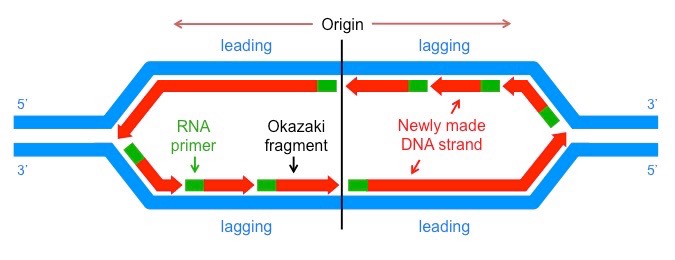DNA Synthesis Begins at Replication Origins

- The DNA double helix is normally very stable: the two DNA strands are locked together firmly by many hydrogen bonds formed between the bases on each strand.
- To be used as a template, the double helix must be opened up and the two strands separated to expose unpaired bases. The process of DNA replication is begun by special initiator proteins that bind to double-stranded DNA and pry the two strands apart, breaking the hydrogen bonds between the bases.
- The positions at which the DNA helix is first opened are called replication origins.
- DNA rich in A-T base pairs is relatively easy to pull apart, and regions of DNA enriched in A-T pairs are typically found at replication origins.
- Bacterial chromosomes typically have a single origin of DNA replication.
- Eucaryotic chromosomes contain multipleorigins of replication.
When growing rapidly, bacteria replicate their DNA continually, and they can begin a new round before the previous one is complete. In contrast, DNA replication in most eucaryotic cells occurs only during a specific part of the cell division cycle, called the DNA synthesis phase or S phase.
- Highly condensed chromatin replicates late, while genes in less condensed chromatin tend to replicate early.
- Eucaryotic chromosomes are composed of roughly equal mixtures of DNA and protein. Chromosome duplication therefore requires not only the replication of DNA, but also the synthesis and assembly of new chromosomal proteins onto the DNA behind each replication fork.
- The cell requires a large amount of new histone protein, approximately equal in mass to the newly synthesized DNA, to make the new nucleosomes in each cell cycle. For this reason, most eucaryotic organisms possess multiple copies of the gene for each histone. Vertebrate cells, for example, have about 20 repeated gene sets, most containing the genes that encode all five histones (H1, H2A, H2B, H3, and H4).
Unlike most proteins, which are made continuously throughout interphase, histones are synthesized mainly in S phase, when the level of histone mRNA increases about fiftyfold as a result of both increased transcription and decreased mRNA degradation.
The major histone mRNAs are degraded within minutes when DNA synthesis stops at the end of S phase.